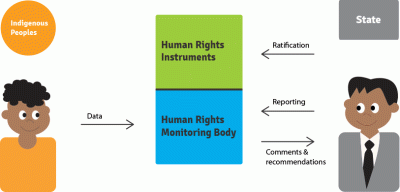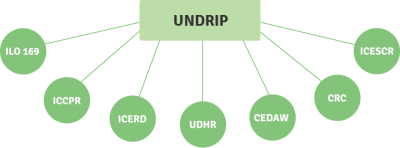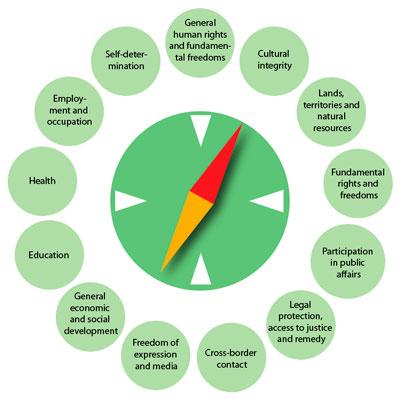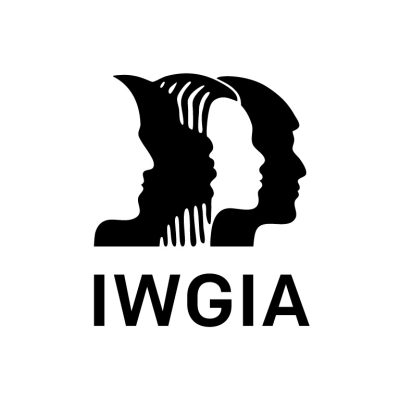What is the Indigenous Navigator?
The Indigenous Navigator is a framework and set of tools for and by indigenous peoples to systematically monitor the level of recognition and implementation of their rights.

Indigenous communities, who have applied the tools to generate data on their situation, are not only better equipped to enter into dialogue with duty-bearers and external stakeholders about the promotion of their rights.
The Indigenous Navigator in a nutshell
The Indigenous Navigator is a framework and set of tools for and by indigenous peoples to systematically monitor the level of recognition and implementation of their rights. By using the Indigenous Navigator, indigenous organisations and communities, duty bearers, NGOs and journalists can access free tools and resources based on community-generated data.
The Indigenous Navigator monitors the implementation of:
- The UN Declaration on the Rights of Indigenous Peoples;
- Core human rights conventions as they pertain to indigenous peoples;
- Essential aspects of the Sustainable Development Goals;
- The outcomes of the World Conference on Indigenous Peoples.
The Indigenous Navigator uncovers the crucial links between the United Nations Declaration on the Rights of Indigenous Peoples (UNDRIP), the commitments put forward in the Sustainable Development Goals and in the Outcome Document of the World Conference on Indigenous Peoples.

The Pilot Phase
Launched in 2014, the Indigenous Navigator project was piloted in 6 countries, namely, Peru, Kenya, Cameroon, Suriname, Thailand and Nepal. Preliminary data sets were collected and used at the national level. Experiences during the pilot testing of the Indigenous Navigator tools demonstrated that applying the Indigenous Navigator tools to generate data on the recognition, protection and fulfilment of the rights enshrined in the UNDRIP has an empowering effect in itself.
Indigenous communities, who have applied the tools to generate data on their situation, are not only better equipped to enter into dialogue with duty-bearers and external stakeholders about the promotion of their rights. They have also developed a much higher level of awareness of their rights through the data generation-process.
Read more about pilot phase experiences
The Second phase
In 2017, the Indigenous Navigator initiative moved into its second phase. Starting in early 2017 the tools have been applied by indigenous organisations and communities in 11 countries: Bangladesh, Cambodia, Nepal, Philippines, Bolivia, Colombia, Peru, Suriname, Cameroon, Kenya and Tanzania. These surveys have been generating in-depth data from 2018, which is available on the Indigenous Navigator's data portal.
The Third phase
In 2022, the Indigenous Navigator began its third phase. Starting in 2022, the tools have been applied by Indigenous organisations and communities in 29 countries across Asia, Africa, the Americas and the Arctic:
Asia: Bangladesh, Cambodia, India, Japan, Nepal, Philippines, Malaysia, Myanmar, Thailand
Africa: Cameroon, Kenya, South Africa, Tanzania, Uganda
Americas: Argentina, Bolivia, Brazil, Chile, Colombia, Ecuador, Guyana, Honduras, Mexico, Paraguay, Peru,
Suriname
Arctic: Sápmi (Finland, Norway and Sweden) together with the Saami peoples.
Purpose and use
Documenting the human rights and development situation of indigenous peoples is a critical step towards discussing it with duty-bearers and other external stakeholders.
The Indigenous Navigator has been developed in response to the need for quality data that can be fed into existing human rights and sustainable development monitoring processes at local, national, regional and international levels. The tools facilitate indigenous communities’ own generation of quality data on their situation and simultaneously enhances their awareness of their rights.
A meticulous comparison between the UNDRIP and other human rights instruments is built into the framework in order to show how the UNDRIP provisions reflect rights enshrined in other human rights instruments. Thereby, Indigenous Navigator data is directly relevant for monitoring the full range of generally applicable human rights instruments as they pertain to indigenous peoples.
In order to further make the Navigator relevant for multiple purposes, the monitoring framework has taken into account that provisions of the UNDRIP are highly relevant for a rights-based implementation of the Sustainable Development Goals (SDGs). Indigenous Navigator data can, therefore, feed into SDG monitoring, planning and programming.
Likewise, the monitoring framework takes into consideration the 2014 World Conference on Indigenous Peoples (WCIP) and the commitments States made in that context to step up efforts to implement the UNDRIP. The Indigenous Navigator data is therefore relevant for monitoring whether States implement the commitments made at the WCIP.
While the tools have been developed for indigenous communities, they are also relevant and useful for NGOs, human rights institutions and specialists, development actors and others who need to anchor their work in the provisions of the UNDRIP. Without necessarily using the questions for data collection, they can, for example, make use of the series of indicators to monitor their own interventions; explore the links between the UNDRIP and other human rights instruments; design targeted programmes to reach the SDGs based on the UNDRIP, etc.
The monitoring machine
We believe that community-generated data can assist indigenous peoples in documenting important gaps in the implementation of their rights and thus be a strategic tool to guide sustainable rights based development agenda. But how can monitoring help indigenous peoples? The Indigenous Navigator can serve a number of purposes – for example:
- Raise awareness of indigenous communities about their rights and contribute to their empowerment and ability to claim their rights;
- Guide and orient indigenous peoples’ self-determined governance and development strategies;
- Hold States accountable by evidencing their compliance with – or failure to meet – human rights obligations with regards to indigenous peoples;
- Deliver data on indigenous peoples’ human rights and development situation to UN agencies and UN mechanisms addressing indigenous peoples' rights (UN Special Rapporteur, EMRIP, UNPFII);
- Evidence whether States are complying with the commitments they made at the World Conference on Indigenous Peoples (WCIP);
- Guide and orient development policies and development programs, including those designed to reach the Sustainable Development Goals (SDGs).
- Generate attention and action in relation to the recognition and protection of indigenous peoples rights
Recommended by the UN Permanent Forum on Indigenous Issues
At its 16th session in April-May 2017, the Permanent Forum adopted a recommendation encouraging Governments, United Nations agencies, indigenous peoples and civil society organisations to use the Indigenous Navigator framework and tools in order to strengthen community-based monitoring of global commitments made under the Declaration, the World Conference, and the Sustainable Development Goals. (E/C.19/2017/L.6)
Why was the Indigenous Navigator developed?
In 2007, the United Nations adopted the United Nations Declaration on the Rights of Indigenous Peoples (UNDRIP).
The Declaration is the most comprehensive international instrument dealing with indigenous peoples’ rights. It does not create new or special rights for indigenous peoples, but is a reflection of universal human rights as they pertain to indigenous peoples.
The adoption of UNDRIP was followed up by the adoption of the Outcome Document of the World Conference on Indigenous Peoples Rights by the United Nations General Assembly in September 2014, which reaffirms State commitment to advance in the practical implementation of the UNDRIP and provides comprehensive recommendations for concrete actions at national and international level.
Documenting the gaps
A decade after the adoption of the UN Declaration on the Rights of Indigenous Peoples (UNDRIP), indigenous peoples’ rights remain disregarded and ignored. States have insufficiently reflected their rights in national legislation, policies and practices. Indigenous peoples continue to face human rights violations, exclusion, and marginalisation. Displacement from their lands and territories, illegal land grabbing and lack of access to justice are among the situations that continue to place their right to a life in freedom out of reach of too many indigenous peoples.

There is a risk that these human rights concerns remain unaddressed, or are even aggravated further. However, indigenous peoples around the globe continue to claim their rights. The Indigenous Navigator Initiative is an attempt by a partnership of Indigenous Peoples Organisations, NGOs, UN agencies and National Human Rights Institutions to join forces in supporting indigenous peoples to monitor the implementation of their rights and to raise awareness through documenting the implementation gaps.
Community-generated data to advance rights
The Indigenous Navigator initiative is the first time ever a comprehensive monitoring framework has been developed for the UN Declaration on the Rights of Indigenous Peoples.

The 46 articles of the UNDRIP has been grouped into 12 thematic domains. For each domain attributes have been identified and indicators have been developed. In addition to measuring UNDRIP implementation, the indicators can also be used to monitor key aspects of the Sustainable Development Goals and the commitments made by UN Members States towards indigenous peoples at the World Conference on Indigenous Peoples in 2014.
The Indigenous Navigator indicators framework covers three different aspects and levels of implementation: Structure. Process. Outcome.
The specific tools developed by the Indigenous Navigator Initiative to gather and support the compilation of data to monitor the implementation of indigenous peoples rights are the following:
- A Tools database and comparative matrix that illustrates how UNDRIP articles are directly linked to other international human rights and labour standard instruments, which makes it possible to track provisions of the UNDRIP to other human rights instruments. As well as comprehensive guidance and methodology on the domains covered by the Indigenous Navigator. This enables indigenous peoples to back up claims of lack of implementation of the UNDRIP with legally binding instruments ratified by Nation States.
- Two comprehensive questionnaires translate the indicators into simple questions that indigenous communities and organisations can use to collect qualitative and quantitative data on their human rights situation. The questionnaires can be filled in online and offline or simply carried to the field in paper copies.
- Indigenous Navigator Index: The Indigenous Navigator Community Index and the Indigenous Navigator National Index are tools that serve to rank countries’ performance with regard to recognizing and implementing indigenous peoples’ rights. This means: are laws, policies and government programmes in line with the UNDRIP?
- Indicators framework: The indicators serve to detect gaps in implementation, hold duty-bearers accountable, and devise implementation strategies. The indicators can also be used to measure essential aspects of the Sustainable Development Goals (SDGs) as well as the commitments made by States at the 2014 World Conference on Indigenous Peoples (WCIP).
All tools provided by the Indigenous Navigator also work as innovative instruments for collective reflection, capacity building, planning and advocacy efforts carried out by indigenous communities and organisations to claim their rights.
Why data collection and indicators for indigenous peoples?
The data generated through the Indigenous Navigator can feed into rights advocacy, policy dialogues, development planning, and awareness-raising campaigns.
If uploaded to a global platform, where data can help generate a better understanding of indigenous peoples’ different situations and struggles across the world.
Where official statistical data disaggregated by ethnicity or indigenous identity exists, the Indigenous Navigator data adds an important community-based dimension to the data landscape.
Read more about why indigenous data is needed here.
Contact

